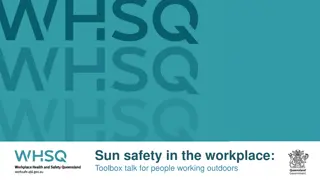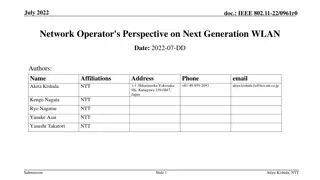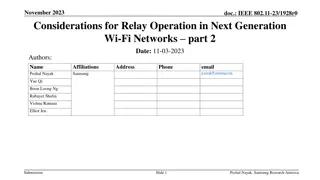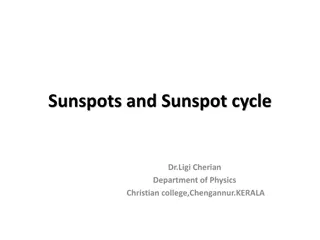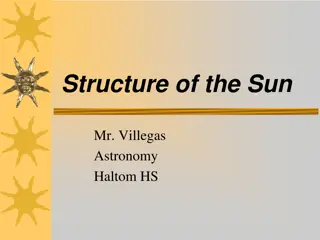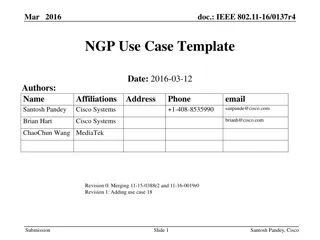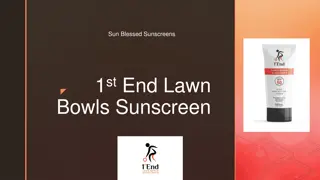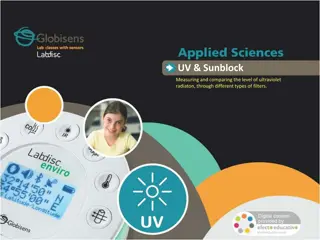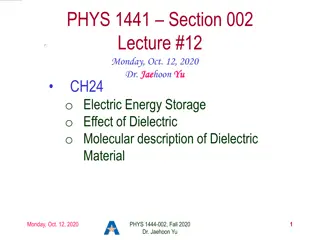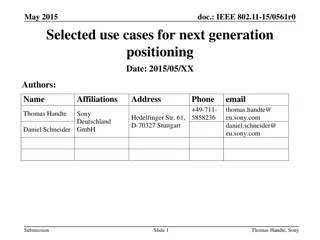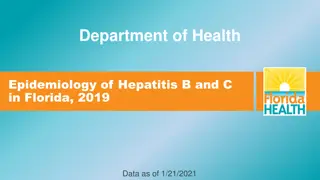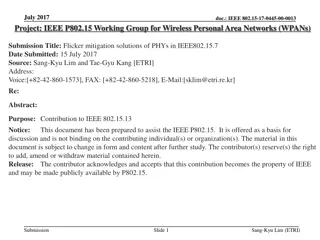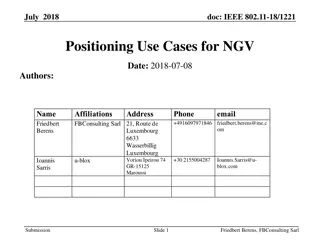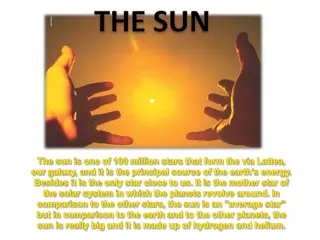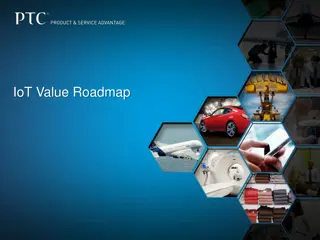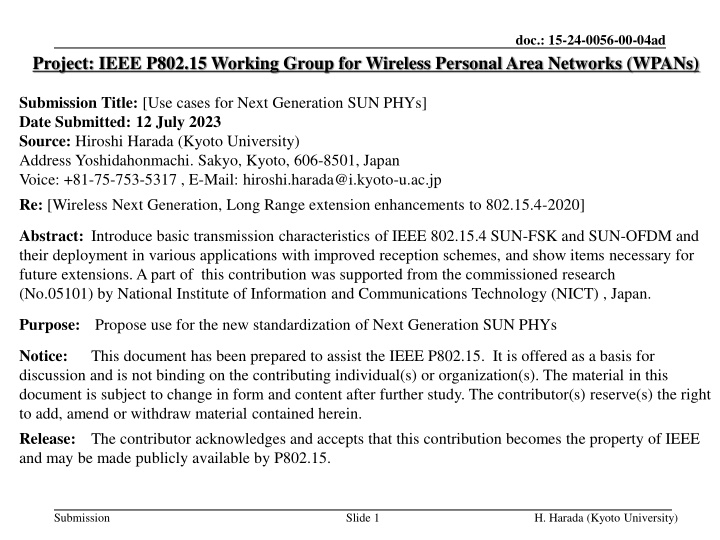
Next Generation SUN PHYs: Use Cases and Applications
Explore the diverse application scenarios and proposed use cases for Next Generation SUN PHYs introduced in the submission by Hiroshi Harada from Kyoto University. The document highlights various areas beyond smart metering, such as disaster prevention, infrastructure monitoring, and medical applications, where SUN technology can be utilized. Detailed transmission characteristics of IEEE 802.15.4 SUN-FSK and SUN-OFDM are discussed, along with potential extensions for future deployments.
Download Presentation

Please find below an Image/Link to download the presentation.
The content on the website is provided AS IS for your information and personal use only. It may not be sold, licensed, or shared on other websites without obtaining consent from the author. If you encounter any issues during the download, it is possible that the publisher has removed the file from their server.
You are allowed to download the files provided on this website for personal or commercial use, subject to the condition that they are used lawfully. All files are the property of their respective owners.
The content on the website is provided AS IS for your information and personal use only. It may not be sold, licensed, or shared on other websites without obtaining consent from the author.
E N D
Presentation Transcript
doc.: 15-24-0056-00-04ad Project: IEEE P802.15 Working Group for Wireless Personal Area Networks (WPANs) Submission Title: [Use cases for Next Generation SUN PHYs] Date Submitted: 12 July 2023 Source: Hiroshi Harada (Kyoto University) Address Yoshidahonmachi. Sakyo, Kyoto, 606-8501, Japan Voice: +81-75-753-5317 , E-Mail: hiroshi.harada@i.kyoto-u.ac.jp Re: [Wireless Next Generation, Long Range extension enhancements to 802.15.4-2020] Abstract: Introduce basic transmission characteristics of IEEE 802.15.4 SUN-FSK and SUN-OFDM and their deployment in various applications with improved reception schemes, and show items necessary for future extensions. A part of this contribution was supported from the commissioned research (No.05101) by National Institute of Information and Communications Technology (NICT) , Japan. Purpose: Propose use for the new standardization of Next Generation SUN PHYs Notice: discussion and is not binding on the contributing individual(s) or organization(s). The material in this document is subject to change in form and content after further study. The contributor(s) reserve(s) the right to add, amend or withdraw material contained herein. Release: The contributor acknowledges and accepts that this contribution becomes the property of IEEE and may be made publicly available by P802.15. This document has been prepared to assist the IEEE P802.15. It is offered as a basis for Submission Slide 1 H. Harada (Kyoto University)
Jan 2024 doc.: 15-24-0056-00-04ad Use cases for Next Generation SUN PHYs Jan 16, 2024 Hiroshi Harada, Ph.D. Submission Slide 2 H. Harada (Kyoto University)
Jan 2024 doc.: 15-24-0056-00-04ad Background Wireless SUN is expected to be used in various fields other than smart metering This contribution will focus on a variety of areas beyond smart metering and propose use cases for Next Generation SUN PHYs Wide-area communications will require the use of VHF bands, etc., rather than Sub-GHz Submission Slide 3 H. Harada (Kyoto University)
Jan 2024 doc.: 15-24-0056-00-04ad Proposed Use Cases Use-Case Name Description Device Density Data Rate Typical packet size Packets per hour Transmit Range Frequency Range Disaster prevention Monitoring : High-speed Cliff collapse and water level monitoring using moving images Up to 10 Mbit/s Always connected Sub-GHz VHF band 10 per km^2 2000 byte Up to 10 km Disaster prevention Monitoring : Low-speed Environmental sensing using acceleration sensors, rainfall sensors, etc. 1000 per km^2 Up to 100 kbit/s Sub-GHz VHF band 500 byte 60 Up to 20 km Infrastructure monitoring : High-speed Structural health monitoring using moving and still images Up to 10 Mbit/s Always connected Sub-GHz VHF band 0.1 per m^2 2000 byte Up to 10 km Structural health monitoring of bridges, buildings, and so on using acceleration sensors, tilt sensors, vibration sensors, etc. Infrastructure monitoring :Low-Speed Up to 100 kbit/s Sub-GHz VHF band 1 per m^2 500 byte 3600 Up to 10 km Medical application : High-speed Telemedicine system using video and still images 100 per km^2 Up to 10 Mbit/s Always connected Sub-GHz VHF band 2000 byte Up to 10km Biological monitoring such as blood pressure, fever, etc.on in hospital wards and nursing homes Medical application : Low-speed Up to 100 kbit/s Sub-GHz VHF band 0.1 per m^2 500 byte 1 Up to 100m Submission Slide 4 H. Harada (Kyoto University)
Jan 2024 doc.: 15-24-0056-00-04ad Proposed Use Cases Use-Case Name Description Device Density Data Rate Typical packet size Packets per hour Transmit Range Frequency Range Connection of sequencers to assembly and processing equipment in the plant Factory : High-speed Always connected 10 per m^2 Up to 5 Mbit/s 2000 byte Up to 1km Sub-GHz Environmental monitoring of temperature, humidity, air, etc. in the factory Factory : Low-speed Up to 100 kbit/s 1 per m^2 500 byte 100 Up to 1km Sub-GHz Crop growth monitoring using still and moving images Agriculture : High-speed 1000 per km^2 Sub-GHz VHF band Up to 5 Mbit/s 2000 byte 10000 Up to 10km Environmental monitoring using various sensors on farms and fields Agriculture : Low-speed 10000 per km^2 Up to 100 kbit/s Sub-GHz VHF band 500 byte 10 Up to 10 km Growth monitoring at aquaculture sites using still and moving images Fisheries : High-speed 100 per km^2 Sub-GHz VHF band Up to 5 Mbit/s 2000 byte 10000 Up to 20 km Environmental monitoring using various sensors on farms and fields Fisheries : Low-speed 1000 per km^2 Up to 100 kbit/s Sub-GHz VHF band 500 byte 10 Up to 20 km Submission Slide 5 H. Harada (Kyoto University)
Jan 2024 doc.: 15-24-0056-00-04ad Proposed Use Cases Use-Case Name Description Device Density Data Rate Typical packet size Packets per hour Transmit Range Frequency Range Monitoring of traffic conditions on the road, low latency control information for automated operations (e.g. automated vehicle) Intelligent transport systems: High- speed 10000 per km^2 Always connected Sub-GHz VHF band Up to 5 Mbit/s 2000 byte Up to 10 km Roadside monitoring with environmental sensors: temperature, humidity, air, etc. in the factory Intelligent transport systems: Low-speed 10000 per km^2 Up to 100 kbit/s Sub-GHz VHF band 2000 byte 5000 Up to 10km Transmission of traffic- related information to vehicles (e.g. automated vehicle) Submission Slide 6 H. Harada (Kyoto University)



